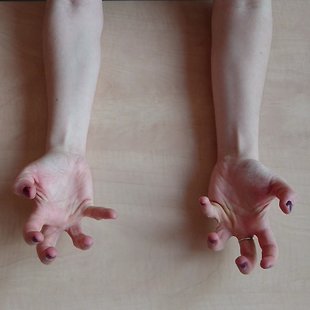Anaesthesia in myotonia congenita Becker
Myotonia congenita Becker is an autosomal recessive disease, non-dystrophic myotonia. The worldwide prevalence of myotonia congenita is about 1:100,000. It is linked to mutations in CLCN1, the gene encoding the skeletal muscle chloride channel. The mutation in Becker’s disease leads to reduced flow of chloride ions during repolarisation leading to sustained muscle contraction. The reduced chloride conductance of the mutated chloride channels in Becker’s myotonia causes hyper-excitability of the muscle fibre membrane leading to bursts of aberrant action potentials. The algorithm will lead you through the anesthesia in patient suffering from this disease from preoperating examination to his awakening.
Review
The algorithm is dedicated to a rare neurological disease, congenital recessive form of myotonia congenita Becker. The algorithm logically leads from the first contact with the patient through the entire perioperative period up to the potential discharge from the hospital. Takes into account all stages of the decision-making process with an emphasis on the key factors that can complicate the health condition of the patient and operating performance. The individual steps of the algorithm are logical and smoothly follow each other. In addition to the correct answers, it suggests a possible common mistakes and incorrect procedure. The specified model belongs among the typical clinical situation. A great advantage of the algorithm is the fact that it confronts the doctor with realistically created situations of rare, but serious, disease. It is possible at any time to "step back" from mistakes which would mean a serious complication in real situation, and it allows to learn and choose the correct procedure. In real life this is not possible. Another advantage of the algorithm is the theoretical information/note, which increases the level of knowledge about this rare disease.
Sources
ŠTOURAČ Petr, KOSINOVÁ Martina. Anaesthesia recommendations for patients suffering from Recessive myotonia congenita (Becker´s disease) Orphan Anesthesia. [online] last update 10. 2016 [cit. 5.11. 2017] available at: http://www.orphananesthesia.eu/en/component/docman/doc_download/278-becker’s-disease.html
Anesthesia & Analgesia. The History of Target-Controlled Infusion. Michel M. R. F. STRUYS; Tom DE SMET; John (Iain) B. GLEN; Hugo E. M. VEREECKE; Anthony R. ABSALOM; Thomas W. SCHNIDER. 122(1):56–69, JAN 2016 Available at: https://insights.ovid.com/pubmed?pmid=26516804
MUDr. KŘIKAVA Ivo, Ph.D. TCI – target controlled infusion [online]. Brno: KARIM FN Brno, LF MU, 2014 [cit. 5.11. 2017]. Available at: http://www.akutne.cz/res/publikace/tci-target-controlled-infusion1-final.pdf
ADAMUS Milan. Monitorování svalové relaxace. Available at: http://www.lf.upjs.sk/ceea/doc5/05%20Adamus%20Monitorov%C3%A1n%C3%AD%20svalov%C3%A9%20relaxace%20CEEA%202013.pdf
Souhrn údajů o přípravku, Bridion 100MG/ML INJ SOL 10X2ML available at: http://www.ema.europa.eu/docs/cs_CZ/document_library/EPAR_-_Product_Information/human/000885/WC500052310.pdf
KOSINOVÁ M, ŠTOURAČ P, KŘIKAVA I, HRUBAN L, JANKŮ P, VOHÁŇKA S. Myotonia congenita becker u pacientky podstupující plánovaný císařský řez v celkové anestezii kazuistika. Brno: RocSugIO, KARIM FN Brno a LF MU. Dostupné z: http://www.akutne.cz/res/file/Vyuka%20-%20posterova%20sekce/2015-kosinova.pdf
Related algorithms
- Acute abdomen from a anesthesiological viewpoint
- Malignant Hypertermia - 2014
- Anesthesia for thoracic surgery
- Anaesthesia of obese patient
- Preoperative evaluation and patient preparation
- Anaesthesia in the elderly patients
- Anaesthesia of newborn
- Neuromuscular Blockade Monitoring
- Anaesthetic Management of Patient with Diabetes Mellitus
- Anaesthetic Management in THA
- Target Controlled Infusion Anaesthesia





